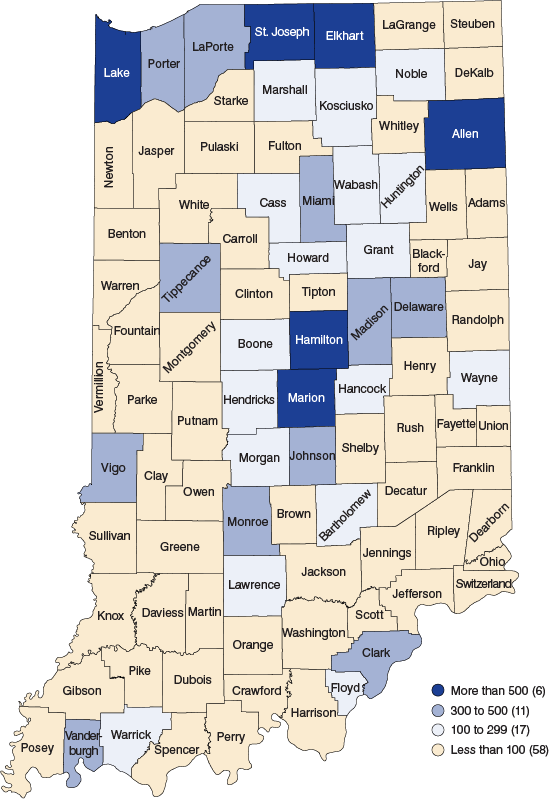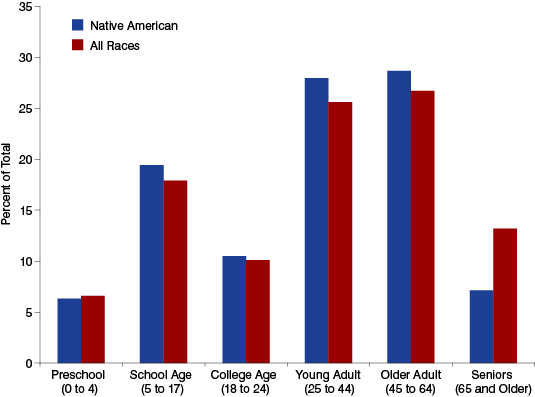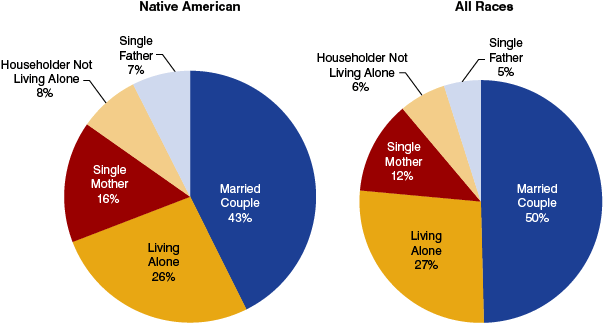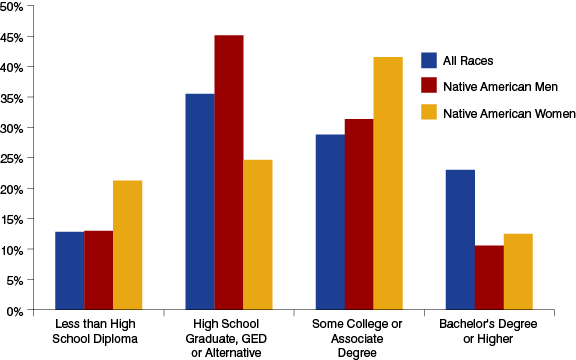Exploring Hoosier Minority Groups: Indiana's Native American Population
Indiana’s population has become increasingly diverse in terms of race and origin. Results from the latest census count for 2010 provide us with a rich set of information from which to gain insight into our population diversity. This article is the last of four InContext articles to provide demographic snapshots of our minority population. Native Americans comprised 0.3 percent of Indiana’s population in 2010 and will be the focus of this snapshot. (View the articles on Indiana’s black population, Indiana’s Hispanic population and Indiana’s Asian population.) The overview that follows focuses on population, household formation, income and education.
Population
18,462 Hoosiers reported Native American as their only race (“American Indian and Alaska Native alone” in Census Bureau lingo) in 2010. The number of Native Americans by county ranges from 11 in Benton County to 2,901 in Marion County (see Figure 1). Miami (0.9 percent) and Wabash (0.7 percent) are the only two counties where Native American exceed 0.5 percent of the total population.
Figure 1: Native Americans by County, 2010

Source: IBRC, using Census 2010 data
All statistics in this article are for the Native American alone population, but it is worth noting that an additional 31,276 Hoosiers report having some Native American ancestry in combination with another race. While the Native American alone population makes up just 0.3 percent of Indiana’s total population, those who specified their race as American Indian and Alaska Native alone or in combination with another race account for 0.8 percent of the total population. Table 1 shows that Cherokee is the most common tribe in Indiana for both groups.
Table 1: Top 10 Tribes Specified for Indiana’s Native American and Multiracial Population, 2010
| Tribe | Native American Alone | Tribe | Multiracial Population Reporting Race as Native American in Combination with Another Race |
|---|---|---|---|
| Cherokee | 3,036 | Cherokee | 12,583 |
| Mexican American Indian | 938 | Blackfeet | 2,065 |
| Chippewa | 618 | Mexican American Indian | 1,441 |
| Sioux | 508 | Sioux | 1,340 |
| Blackfeet | 375 | Chippewa | 1,208 |
| Potawatomi | 368 | Choctaw | 852 |
| Choctaw | 323 | Apache | 824 |
| Apache | 277 | Potawatomi | 724 |
| Iroquois | 255 | Iroquois | 640 |
| Navajo | 230 | Navajo | 547 |
- Update 5/21/2015 - This table is based on Census Bureau Table QT-P7, which does not include the Miami tribal grouping. Indiana has a large Miami (alone) population totaling 1,432 across all categories within that tribal grouping.
Note: Not everyone who reported their race as Native American also specified a tribe.
Source: IBRC, using Census 2010 data
Since 2000, Indiana’s Native American population has grown by 16.7 percent—an increase of 2,647 people. However, one-third of counties experienced declines in their Native American populations.
The Native American population follows the same basic age trend as the overall population, except for a lower proportion of senior citizens (see Figure 2). The median age for Native Americans is 35 years, compared to 37.1 for the overall population.
Figure 2: Indiana Age Distribution, 2010

Source: IBRC, using Census 2010 data
Households
Census 2010 reports 6,912 Native American households in the state. (When it comes to race at the household level, the household is characterized based on the race of the primary householder.) Forty-three percent of those households are comprised of married couples, while an additional 26 percent consist of individuals living alone (see Figure 3).
Figure 3: Indiana Households by Type, 2010

Note: The single-mother category is “female householder, no husband present” and the single-father category is “male householder, no wife present.”
Source: IBRC, using Census 2010 data
Forty-one percent of the Native American population lives in rented units, compared to 28 percent of the total population (see Table 2).
Table 2: Indiana Homeownership, 2010
| Indicator | Native American | All Races |
|---|---|---|
| Owned with a Mortgage or a Loan | 47% | 57% |
| Owned Free and Clear | 12% | 16% |
| Renter Occupied | 41% | 28% |
Note: These percentages are based on the population in occupied housing units.
Source: IBRC, using Census 2010 data
Income and Educational Attainment
Since Census 2010 did not collect any economic data, we must turn to the 2011 American Community Survey (ACS) for this information. Per capita income in 2011 was $14,431 for Indiana’s Native American population, compared to $23,524 for the overall population. Meanwhile, the median household income for Indiana’s Native American households was $34,558—nearly $12,000 less than the median for all households in the state ($46,438).
The Indiana Native American poverty rate was 25 percent according to the ACS, compared to 16 percent for the overall population.
Figure 4 shows educational attainment for the Native American population broken down by gender. Eighty-seven percent of Native American men have a high school diploma or higher, compared to 79 percent of Native American women.
Figure 4: Indiana’s Adult Educational Attainment, 2011

Note: Educational attainment statistics are calculated for those age 25 and older.
Source: IBRC, using American Community Survey data
Learn More
To access more data about Indiana’s Native American population, visit American FactFinder from the U.S. Census Bureau at https://data.census.gov, which contains data from both Census 2010 and the latest American Community Survey.
For a look into Indiana’s other minority groups, visit other articles in this series:
